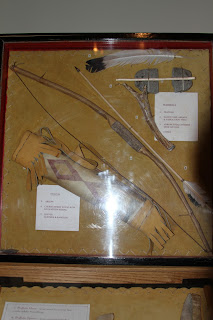Lethbridge, Alberta
Oki, Kiitsiksiksimaatstsimohpinaan (Indian for Hello, We welcome you). Longer than
SUPERCALIFRAGILISTICEXPIALIDOCIOUS which I can say.
Ray's first wildlife sighting of the day.
 |
This is the campground where we are staying.
 |
| On the way to the Buffalo Jump. |

Head-Smashed-In Buffalo Jump is located about 35 miles from the campground that we will call home until Saturday; it is where the foothills of the Rocky Mountains meet the Great Plains. This is a UNESCO world heritage site since 1981 and one of the largest and oldest buffalo jump site in North America. Head-Smashed-In has been used by the Blackfoot peoples of the plains for more than 5,500 years.
According to the legend, the name Head-Smashed-In Buffalo
Jump comes from a young Peigan boy who stood under the cliff during one particular
hunt to get an up-close view of the buffalo falling over the ledge. However,
the hunt was large and the young brave was soon crushed. When his people came
to do the butchering, they found him with his skull crushed by the weight of
the buffalo carcasses.
 |
| Photo of one of the archaeologists. |
How did the Blackfoot Indians get the buffalo to jump of the
cliff? A strong understanding of buffalo behavior was required for the buffalo
jump to be successful. The hunt began when several young men –the buffalo
runners- were sent out to locate the herds and to manipulate animals into the
lines of rock lanes called “driving lanes”. The lanes consisted of small piles
of rocks spaced about 16 to 32 ft. apart and stitched for many feet to the west
of the cliff. The rock pile would be made larger by adding brush. This was used
like a funnel to the cliff.
By the time the panic-stricken lead buffalo topped the short
rise before the cliff and saw the edge, it was too late. Its own momentum and the herd behind pressed
it over the edge. Every part of the
buffalo was used and nothing was wasted.
This is the main Buffalo Jump. Further along the cliff is another jump. Many others have been discovered in other areas.
The early archaeologists wondered why there we no skills with the bones. It was later discovered that the Indians gathered them and placed them in circle with the belief that they would call other Buffalo to the hunting grounds.
We were told that cougars and bear have been sighted in the area, but all the wild animals we saw were Marmots, which almost posed for us.
 |
| This one actually turned around and faced me. |
 |
| This one was facing the building and got up and turned around, and then laid back down. |
 |
| One of the exhibits. |
 |
| Ray was a lot slower coming up the trail, than I was. |
 |
| One of the uses for Buffalo meat. |
With the senor discount and being in the “off” season the cost was $8.00 each. We spent several hours exploring each level and the grounds. It should not be missed when traveling through Lethbridge.
We also stopped at Fort Macleod. Since Tuesday will be a day of rest, you can't be on the go constantly, I will write about the fort and town then.
Total spent for entertainment $33.00.
Thanks for dropping by.










No comments:
Post a Comment